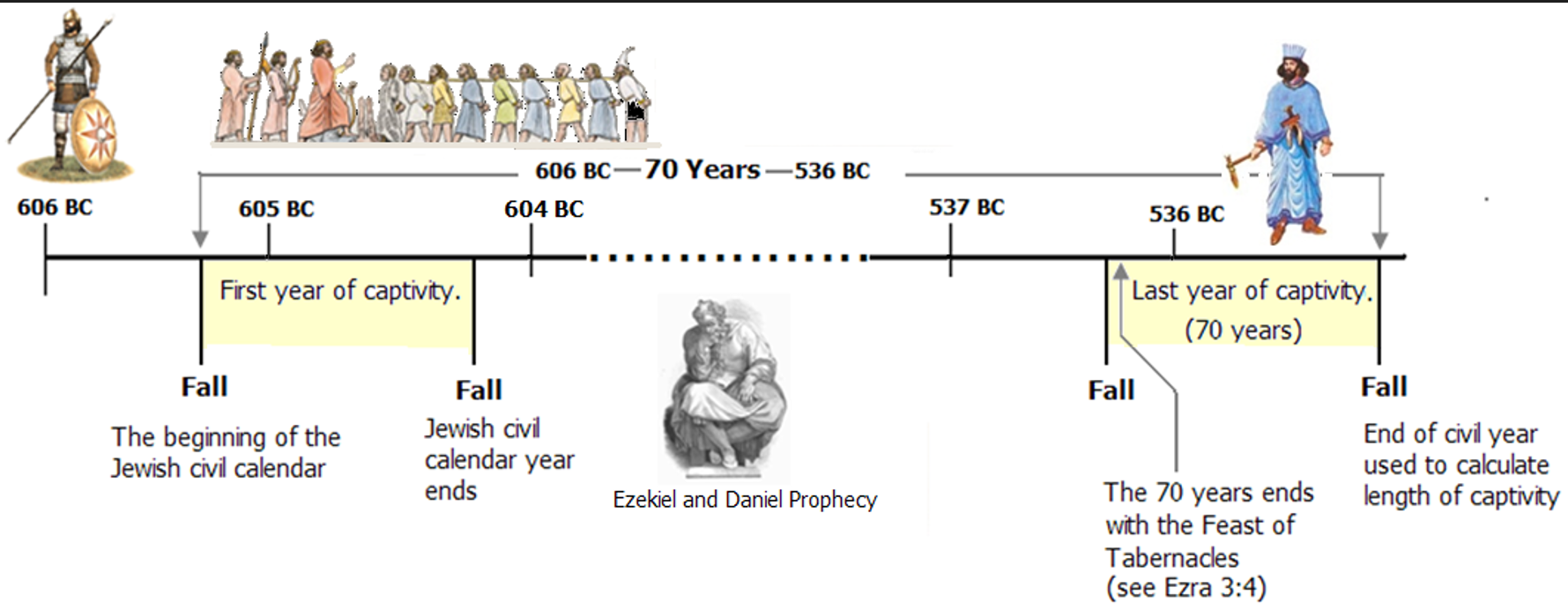

What is below is from http://www.johnpratt.com/items/docs/captivity.html#fn3
Cyrus conquered Babylon in 539 B.C.E., but the Jewish captives did not return to their homeland until 537 B.C.E. Therefore, how could it be said that the Jews served “the king of Babylon” for seventy years if the king of Babylon was conquered two years earlier?
The solution to the problem is given to us by Daniel. He tells us that he and others were taken captive some years before Jehoiachin. He states that Nebuchadnezzar besieged Jerusalem in the third year of Jehoiakim (father of Jehoiachin), and that he, Daniel, was taken captive at that time (Dan. 1:1-3, 6). This account means that Nebuchadnezzar had taken captives even before he was crowned king. Further, Daniel’s account is verified in the history of Nebuchadnezzar by Berossus of Babylon. This Babylonian history, no longer extant, is quoted by Josephus as stating that after Nebuchadnezzar defeated Egypt at Carchemish in Syria (in the spring of 605 B.C.), he immediately “settled the affairs of Egypt, and the other countries” and sent captives from the Jews, Phoenicians, Syrians, and Egyptians to Babylon before he returned there himself (in August) to be crowned king after his father’s death.[5]
But the difference between 605 and 537 B.C. is only 68 years. Why, then, does the biblical account speak of 70? The answer lies in the calendar systems used and in the way ancient Israelites calculated their years.
The Israelites used two calendar systems, one beginning in the fall and one beginning in the spring. Their calendar originally began in the fall; however, after the Lord took the children of Israel out of Egypt, a change was made in their reckoning of years so that the first month was in the spring. (see Ex. 12:2, 13:3-4). The reigns of kings were usually calculated with years beginning in the spring, as in the case of Jehoiachin mentioned above. According to the spring reckoning, the battle of Carchemish occurred in the beginning of the fourth year of Jehoiakim (see Jer. 46:2).
The first key to discovering the answer to our question is this: in Daniel’s history, he uses the calendar system whose years start in the fall, not the spring. As Daniel implies, the battle of Carchemish was in the end of the third year of Jehoiakim according to the fall reckoning (see Dan. 1:1). Daniel’s procedure of starting the year’s count in the fall was the same procedure used in counting the sabbatical years for the land, a principle that was decreed in the law of Moses (see Lev. 25:3-4; see also Bible Dictionary, s.v. “calendar” “sabbatical year”). As the scriptures declare, the 70-year period of captivity was related to sabbath-year counts (see 2 Chr. 36:21); it made up for sabbath years on the land that Israel had not observed. This being the case, we see why Daniel started to count the 70-year period from a fall reckoning. Daniel’s use of fall reckoning for years of captivity makes sense because sabbath years for land were reckoned beginning in the fall.
The second key is to understand that in Jewish reckoning any part of a year can count as a full year. By this reckoning, then, the year beginning in the fall of the year we designate as 606 B.C. on our calendar system would be counted as the first year of the captivity even though the Jews were captive only a short period of the year because Daniel was taken before that year had ended on the Jewish calendar in September of 605 B.C.
In this light, the 70th, or ending year, began 69 years later in the fall of the year we now designate as 537 B.C., during the first year of the reign of Cyrus. The ending point for the 70 years seems to be at the Feast of Tabernacles (see Ezra 3:4), which was celebrated in Jerusalem in the fall only two weeks after the year had begun. That two-week period, however, was enough to extend the captivity into its 70th year, which would end for the Jews in the fall of the year we now designate as 536 B.C.
Counting a small part of the year as a year, then, is the way the Jews would have reckoned the captivity from 605 B.C. to 537 B.C. as 70 years.
Notes
- That year was his eighth year according to Jewish reckoning (see 2 Kgs 24:12) because the Jews counted the year in which he ascended the throne as the first year, whereas the Babylonians reckoned his reign as beginning the next year, in the spring of 604 B.C.
- A.K. Grayson, Assyrian and Babylonian Chronicles , vol. 5 of Texts from Cuneiform Sources, eds. A.L. Oppenheim, and others (1975), 102.
- Adar is the 12th month on both the Babylonian and Jewish calendars, so it was near the end of Nebuchadnezzar’s seventh year, which had begun in the spring of 598 B.C. The exact date is taken from the tables of R.A. Parker and W.H. Dubberstein, Babylonian Chronology 626 B.C.-A.D. 45 (1942), 25, where 1 Adar is listed as 15 March on the Julian Calendar.
- The other year commonly cited is 538 B.C., but that appears to be one year too early.
- Antiquities 10.11.1, trans. W. Whiston, The Complete Works of Josephus (1981), 224-5.